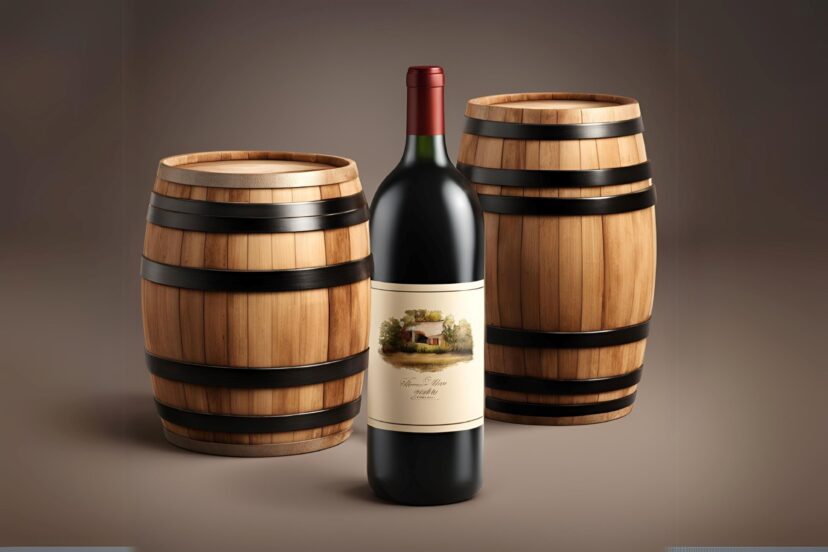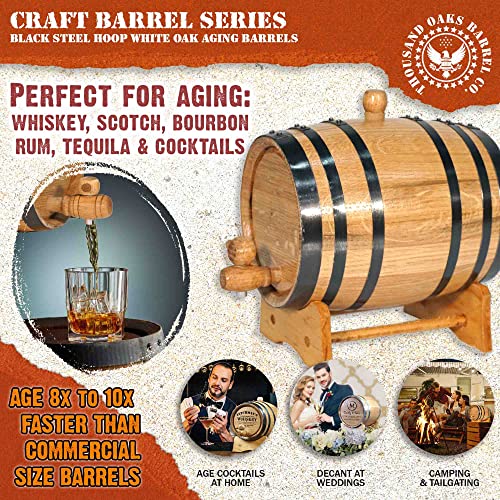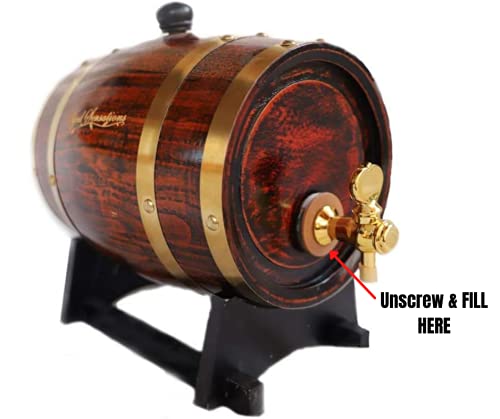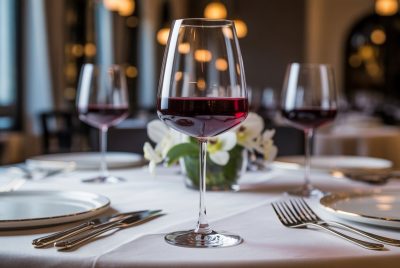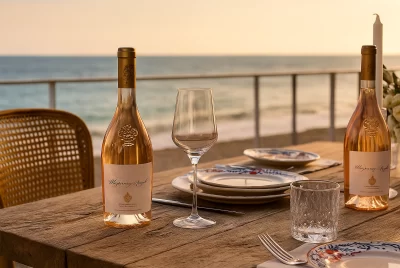Barrels For Winery: Top Choices For Quality Wine Production
Post Disclaimer
*We may earn a commission for purchases made using our links. Please see our disclosure to learn more.
Choosing the right barrel for your winery can feel like finding a needle in a haystack. Every wine maker knows the struggle: you want to enrich your wine, give it that perfect flavor and aroma, but with so many options out there, where do you even start? Here’s an interesting nugget the Barrels for Wine – did you know that the type of barrel used can significantly impact not just the taste and smell of your wine, but also how well it ages over time?
This blog is here to guide you through the maze of barrel selection without breaking a sweat. We’ll explore everything from oak varieties to size and toasting levels, ensuring you make an informed decision best suited for your liquid gold.
By the end, selecting barrels will seem less like rocket science and more like picking out your favorite bottle from the store shelf. Let’s get rolling!
The Importance of Choosing the Right Barrels for Winemaking
Choosing the right barrels for winemaking significantly impacts wine flavor and aroma and influences the aging process. Various types of wine barrels, including new oak vs. used oak, oak vs.
other types of wood, and furniture/decoration grade vs. wine grade must be considered when making this crucial decision.
Impact on wine flavor and aroma
Oak barrels play a crucial role in shaping the taste and scent of wine. As wine ages inside these barrels, it absorbs compounds from the wood, adding layers of complexity, flavor, and aroma that weren’t present before.
Think vanilla notes from American oak or spicy undertones from French oak; these nuances turn a simple beverage into a symphony of taste.
The interaction between the wine and barrel doesn’t just stop at adding flavors; it also influences the wine’s structure and mouthfeel. Oxygen slowly seeps through the wood, softening tannins and allowing the wine to mature into a well-rounded drink.
This process is something stainless steel tanks can’t replicate.
Moreover, certain types of wood can introduce smoked or toasted hints to the mix, depending on how much they were heated during their crafting process. Every barrel tells its own story through each pour—a narrative woven with details about its origin, treatment, and journey alongside the winemaker’s vision for perfection in every glass.
Influence on aging process
Wine barrels play a crucial role in the aging process, impacting both the taste and the lifespan of wine. The type of oak and its origin—be it French, American, or Hungarian—introduces distinct flavors to the wine.
French oak imparts subtle hints of spice and silkiness, enhancing complexity. Meanwhile, American oak contributes bolder vanilla notes with a creamy texture. Choosing between these can make or break the character of your wine.
The interaction between wine and barrel doesn’t stop at flavor infusion; it also involves oxygen exchange. This subtle interaction allows wines to mature gracefully, rounding out tannins for a smoother finish.
A well-aged wine owes much of its elegance to this carefully managed air exposure. Each barrel type offers a different rate of oxygenation due to variances in grain density: fine-grained barrels from cooler climates tend to slow down this exchange.
In winemaking, patience isn’t just a virtue—it’s an ingredient.
Types of Wine Barrels
When it comes to wine barrels, there are various types to consider. You can choose between new oak and used oak, as well as decide whether to go for oak or other wood options. Additionally, you’ll need to select the right grade of barrel for your winemaking needs.
New Oak vs. Used Oak
Choosing the right type of barrel is like picking the perfect spice for your stew – it can completely transform the taste. Let’s break down the differences between new oak and used oak barrels in winemaking through a straightforward table, no frills attached.
| Feature | New Oak Barrels | Used Oak Barrels |
|---|---|---|
| Flavor and Aroma Profile | Introduces robust flavors like vanilla, coconut, and spice. Adds more pronounced woody aromas. | Imparts subtler flavors and aromas, allowing the wine’s fruit character to shine through. |
| Influence on Wine Structure | Can significantly alter the tannin structure, adding complexity and depth. | Less influence on tannin structure, offering a gentler integration of wood character. |
| Cost | More expensive due to the cost of fresh oak. Prices can vary but typically start around $600 for a quality barrel. | Cost-effective. A used barrel can be a fraction of the price, depending on its age and condition. |
| Sustainability | Less sustainable as it requires cutting down more oak trees. | More sustainable, reusing barrels extends their life cycle and reduces demand for new lumber. |
| Life Span | Can be used for winemaking for about 3 to 5 years before the flavors diminish. | Already ‘broken in,’ but can still be effective for aging wine for 2 to 3 years, depending on past use. |
So, whether you’re a casual wine drinker curious about what goes behind your favorite bottle, or a collector looking to start your own batch, understanding the barrel’s role is key. Pick new oak for a bolder transformation or used oak for a dance of subtlety in your wine. Cheers to making informed choices!
Oak vs. Other Types of Wood
Let’s chat barrels, specifically oak versus the rest. Imagine this: you’re choosing between a classic oak barrel and, say, a cedar one. It’s not just about looks; it’s about what happens to your wine.
| Wood Type | Flavor Impact | Aging Potential | Common Usage |
|---|---|---|---|
| Oak | Adds vanilla, spice, and hints of toast | Excellent for aging, can improve flavor complexity over years | Reds and strong whites |
| Cedar | Can impart resinous, pencil-lead nuances | Not typically used for aging, as it can overpower the wine | Rare, experimentally |
| Chestnut | Offers a sharper, somewhat bitter flavor | Less ideal for long aging; can contribute tannins quicker | Historically used, now mostly in rustic or traditional wines |
| Cherry | Gives a fruity, sweet touch | Aging potential varies; often used for shorter periods | Fruit wines, some experimental reds |
| Acacia | Brings floral, fresh grassy notes | Can age wine well without imparting too much flavor | Whites, for a subtle influence |
So, you see, oak’s like the Swiss Army knife of barrels. It does a bit of everything and does it well. Other woods? They’re more like specialized tools. Great in the right hands, but you gotta know what you’re getting into. Choose wisely, and your wine will thank you. Cheers!
Furniture/Decoration Grade vs. Wine Grade
Picking the right wine barrel is like choosing the perfect spice for your stew – it makes all the difference. Today, we’re slicing through the clutter to talk barrels, particularly focusing on Furniture/Decoration Grade versus Wine Grade. Buckle up!
| Aspect | Furniture/Decoration Grade | Wine Grade |
|---|---|---|
| Purpose | Meant for aesthetics, not aging wine. Think living room corner piece. | Made for aging wine to perfection. |
| Wood Quality | Looks matter more than substance. Any wood type, as long as it’s pretty. | Only the best. Typically, high-quality oak that enhances wine’s flavor. |
| Construction | Not built to hold liquids. Seals? What seals? | Watertight and airtight, to keep the good stuff in and the bad stuff out. |
| Impact on Wine | None, unless you count the conversation it starts. | Massive. Can add notes of vanilla, spice, or smoke, depending on the toast. |
| Price | Often cheaper, since function is not a priority. | Investment alert! But keep in mind, quality wine deserves a quality barrel. |
Choosing the right barrel is more than just picking oak over pine. It’s about ensuring your wine has the perfect home to mature into the bottle of joy you envision. Now, let’s discuss factors to consider when selecting these crucial companions for your wine.
Factors to Consider When Choosing Barrels
When choosing barrels, it’s essential to consider the size and capacity, the toasting levels, and also the barrel age and history. These factors will directly impact the flavor and aging process of your wine.
Size and Capacity
When selecting wine barrels, it’s crucial to consider the size and capacity. The volume of a barrel directly impacts the surface area in contact with the wine, affecting the flavor and aging process.
Smaller barrels allow for more oak-to-wine contact, accelerating the maturation process, while larger ones provide a slower, subtler influence on the wine. Winemakers typically select barrel sizes based on their desired outcome for the wine, whether it’s bold flavors from smaller barrels or a softer touch from larger ones.
In general, red wines tend to benefit from smaller barrels due to increased oak extraction and faster aging, while white wines often fare better with larger capacities for milder oak influence.
This consideration plays a significant role in crafting balanced and nuanced wines.
The size and capacity of wine barrels not only determine oak exposure but also impact overall production efficiency. Larger barrels are well-suited for high-volume wineries looking to streamline operations and maintain consistency across batches.
On the other hand, boutique winemakers may opt for smaller vessels to experiment with different oaks or create unique small-batch wines that require specialized care during fermentation and aging processes.
The careful selection of barrel size can significantly contribute to achieving specific flavor profiles tailored to each winery’s distinctive offerings.
Toasting Levels
The toasting level of a wine barrel impacts the flavors and aromas of the wine. Winemakers carefully consider this factor as it directly influences the final product. The toasting process caramelizes the natural sugars in wood, enhancing the complexity of the wine.
It also imparts varying levels of smokiness and spiciness, contributing to the overall character of the wine.
Different toasting levels produce distinct results in wine aging. Light toast is known for preserving fruit flavors while adding subtle vanilla notes, ideal for white wines and delicate reds.
Medium toast enhances spice characteristics and imparts a balanced influence on both red and white wines. On the other hand, heavy toast introduces rich caramelized undertones suited for robust red wines.
Understanding these toasting options allows winemakers to craft wines with specific flavor profiles that delight enthusiasts across different preferences.
Moving on from Toasting Levels, let’s dive into considering Barrel Age and History when selecting barrels for winemaking.
Barrel Age and History
The age and history of wine barrels can greatly impact the flavors and aromas of the wine they produce. The aging process is influenced by the history of the barrel, as newer barrels impart stronger flavors while older ones mellow out the influence on the wine.
The age of a barrel can also showcase its previous use, potentially enhancing or altering the resulting wine. Understanding the age and history of different barrels is crucial for winemakers seeking to craft balanced wines with distinct characteristics.
When choosing oak barrels, it’s important to consider their previous use and aging. New oak barrels provide strong flavor profiles due to higher levels of extraction from fresh wood, while used oak barrels offer subtler influences that accentuate specific traits in wines.
Additionally, knowing if a barrel has been previously toasted or charred can help winemakers predict how it will affect their wine’s flavor profile during fermentation and aging processes.
The type of wood used in crafting wine barrels also contributes significantly to their historical importance. French oak, American oak, Hungarian oak—all have distinct qualities that make them desirable choices for various styles of winemaking operations.
Each variety brings its unique nuances that seasoned vintners leverage to tailor flavors tailored towards producing distinctive wines.
Top Choices for Quality Wine Production
When crafting balanced wines, the right barrels play a crucial role. Red Head Barrels, 3 Liter Oak Aging Barrel, and LUXURY Premium OAK “Aged Sensations” are top choices for quality wine production.
You’d be thrilled to learn more about their unique features and how they can elevate your winemaking experience!
Red Head Barrels
Red Head Barrels are renowned for their high-quality oak barrels, which contribute to the development of rich and complex wine flavors. These barrels are carefully crafted from American white oak sourced from sustainable forests, ensuring a reliable and eco-friendly option for winemakers.
Elevate your spirits with the Red Head Barrels 2L Premium Oak Barrel, perfect for aging whiskey, wine, rum, and more. Made from new charred American white oak, this barrel enhances your favorite drinks' flavor and smoothness in weeks. The set includes everything you need: a wooden barrel, stand, spigot, bung, paper funnel, and instructions, plus a 12-page cocktail recipe booklet to inspire your creations.
- High-Quality Material: Made from premium charred American white oak, ensuring a robust and authentic aging process.
- Comprehensive Set: Includes all necessary accessories and a 12-page cocktail recipe booklet.
- Versatile Use: Suitable for aging various spirits, allowing you to experiment with different flavors and craft personalized.
- Limited Capacity: With a 2-liter capacity, it may not be sufficient for large batch aging.
- Requires Maintenance: Regular cleaning and care are needed to maintain the barrel's quality and longevity.
- Initial Preparation Time: The barrel needs to be prepped and soaked before the first use, which can be time-consuming.
Known for their exceptional craftsmanship, Red Head Barrels offer a variety of toasting levels and sizes, allowing winemakers to tailor the aging process according to their specific wine profiles.
With a focus on delivering premium quality and consistent results, Red Head Barrels stand as an excellent choice for producing top-tier wines that impress even the most discerning wine connoisseurs.
The unique combination of high-quality materials and expert craftsmanship make Red Head Barrels a popular choice among wineries aiming to enhance the depth and character of their wines.
The attention to detail in every aspect of production ensures that these barrels remain an instrumental tool in creating exceptional wines year after year.
3 Liter Oak Aging Barrel
The 3 Liter Oak Aging Barrel is a fantastic choice for wine enthusiasts and collectors who want to experiment with small-batch aging. This compact barrel offers the opportunity to impart rich flavors and aromas into your wine, thanks to its high-quality American oak construction.
Enhance your home distilling experience with our 3 Liter Oak Aging Barrel. This wooden barrel is perfect for aging whiskey, bourbon, wine, and cocktails, offering an accelerated aging process due to its smaller size. Made from charred American oak, it infuses your spirits with rich flavors like vanilla, sweet spices, and coconut. Complete with a stand, bung, and spigot, this barrel is a great addition to any home bar and a unique gift for enthusiasts.
- Accelerated Aging: The small size of the barrel allows spirits to age 10 times faster than in larger barrels, delivering a balanced and aged flavor in weeks.
- Rich Flavor Infusion: The charred American oak interior adds natural flavors such as vanilla, sweet spices, and coconut.
- Versatile Use: Suitable for aging a variety of spirits and cocktails, this barrel can be used for multiple aging cycles.
- Initial Setup Required: The barrel needs to be cured before use, which requires following specific instructions and may be time-consuming for some users.
- Limited Capacity: With a 3-liter capacity, the barrel may not be suitable for those looking to age larger quantities of spirits at once.
- Essence Flavoring Not Included: Swish Barrel Essence Flavoring, which can enhance the aging process.
With a capacity of 3 liters, it’s perfect for aging smaller quantities of wine or experimenting with different oaks and toasting levels.
This versatile barrel allows you to have more control over the aging process, enabling you to craft unique and distinct flavor profiles that elevate your wines. Whether you’re looking to enhance the complexity of red wines or add depth to white varieties, the 3 Liter Oak Aging Barrel provides an excellent platform for small-scale experimentation in winemaking.
LUXURY Premium OAK “Aged Sensations”
Create a truly exceptional wine with the LUXURY Premium OAK “Aged Sensations.” This exquisite oak barrel is crafted to enhance the flavors and aromas of your wine, bringing out the rich characteristics that make it unique.
Experience the ultimate in home beverage dispensing with the LUXURY Premium OAK “Aged Sensations” 3 Liter Whiskey Barrel Dispenser. Handcrafted from high-durability, stain-sealed oak and featuring elegant gold-metal banding, this barrel is designed to hold an entire bottle or handle of your favorite liquor, wine, spirits, or beer. The premium, food-grade plastic interior ensures leak-proof performance, while the new brass “turn” nozzle offers easy and convenient pouring, especially for shots. The included stand enhances stability and portability, making this dispenser a stylish and practical addition to any home bar.
- High Durability: Made from stain-sealed oak, this barrel is built to withstand wear and tear, ensuring long-lasting use.
- Generous Capacity: With a 3-liter capacity, it can hold up to two large bottles of wine or two handles of liquor, making it perfect for gatherings.
- Easy Pouring: The new brass “turn” nozzle allows for smooth and convenient dispensing.
- Size: The 3-liter capacity might be too large for individuals or small households with limited space.
- Weight: When filled, the barrel can be heavy, which may make it less convenient to move around frequently.
- Maintenance: The handcrafted oak and brass components may require regular cleaning and maintenance to preserve their appearance and functionality.
Its high-quality construction and distinct oak profile set it apart from other barrels, ensuring that your wine ages gracefully and develops depth and complexity over time. With its superb craftsmanship, this premium oak barrel is an ideal choice for those seeking to elevate their winemaking process.
The LUXURY Premium OAK “Aged Sensations” offers not only quality but also versatility. Whether you are producing reds or whites, this barrel provides the perfect environment for aging your wine to perfection.
Its thoughtful design allows for precise control over the aging process, giving you the freedom to create wines that embody balance and finesse. Elevate your winemaking experience with this exceptional oak barrel that promises to deliver outstanding results every time.
Tips for Proper Maintenance and Care of Wine Barrels
Proper maintenance and care of wine barrels are crucial. It includes cleaning, sanitizing, storage, handling, and occasional re-coopering or repairing to ensure the longevity and quality of the barrels.
Cleaning and Sanitizing Techniques
To ensure the longevity and quality of your wine barrels, it is crucial to employ effective cleaning and sanitizing techniques. Proper maintenance not only prolongs the life of the barrels but also ensures that they do not impact the flavor and aroma of the wine. Here are some essential cleaning and sanitizing techniques for your wine barrels:
- Rinse the barrel with hot water to remove any residue or sediments.
- Use a mixture of citric acid and water for deep cleaning, ensuring all surfaces are thoroughly scrubbed.
- Sanitize the barrel with a sulfur dioxide solution to kill any remaining bacteria or mold.
- Rotate the barrel regularly to prevent stagnant pockets of air or liquid.
Following these simple yet crucial steps will help maintain the integrity and quality of your wine barrels, ensuring that each batch of wine maintains its unique flavors and aromas.
Unlocking the secrets to proper maintenance will ensure that your winemaking journey continues to thrive, setting the stage for a successful aging process for your wines.
Storage and Handling
Proper storage and handling of wine barrels are crucial for maintaining the quality of your wine. Here are some essential tips to ensure the longevity and integrity of your barrels:
- Keep the barrels away from direct sunlight to prevent heat damage and preserve the wine’s delicate flavors.
- Maintain a consistent temperature and humidity level in the storage area to prevent fluctuations that can affect the aging process.
- Regularly inspect the barrels for leaks, mold, or any signs of damage, and address any issues promptly to avoid compromising the wine.
- Rotate and move the barrels periodically to prevent settling or sediment buildup, ensuring uniform aging and flavor development.
- Handle the barrels with care during transportation or repositioning to avoid jostling or impact that could disturb the wine inside.
These practices will help safeguard the quality of your wine throughout its barrel aging process, preserving its unique characteristics and flavors.
Re-coopering and Repairing Barrels
Re-coopering and Repairing Barrels is a crucial aspect of maintaining wine quality and ensuring the longevity of your barrels. Here are some essential tips for proper maintenance:
- Regularly inspect the barrels for any signs of damage, such as leaks or loose staves.
- Re-cooper any damaged staves or heads promptly to prevent wine spoilage.
- Utilize skilled coopers for repairing barrels to maintain their structural integrity.
- Implement a thorough cleaning regimen to remove residual wine and prevent bacterial growth.
- Store barrels in a cool, humid environment to prevent drying out and maintain the wood’s integrity.
These practices will help you preserve the quality and flavor profile of your wines while extending the lifespan of your valuable barrels.
Next heading: Tips for Proper Maintenance and Care of Wine Barrels
Conclusion
In conclusion, these top choices for quality wine production focus on the practicality and efficiency of barrel selection. The strategies discussed emphasize the importance and impact of choosing the right barrels, stressing significant improvements in flavor, aroma, and aging processes.
As you navigate the world of winemaking, it’s essential to consider these approaches for crafting balanced wines. To dive into additional resources or further reading material about cooperage supplies and wine barrel varieties, seek more than just a basic understanding of oak wine barrels.
Unveil the secrets by exploring how our suite can enhance your wine production experience. Remember that tailored barrel selection not only underpins successful winemaking but also ensures efficient utilization in crafting premium wines.
So picture this: an ever-evolving industry where even traditional methods can be robustly enhanced through meticulous consideration when it comes to selecting your wine barrels.
FAQs
1. Why is choosing the right barrel important for winemaking?
The right barrel influences wine flavor, aroma, and aging, making it crucial for achieving the desired wine profile.
2. What’s the difference between new and used oak barrels?
New oak adds stronger flavors like vanilla and spice, while used oak offers subtler, more refined notes.
3. How does barrel size affect wine aging?
Smaller barrels speed up aging with more oak contact, while larger barrels provide a slower, more subtle influence.
4. What impact do toasting levels have on wine?
Toasting levels affect flavor, with light toast preserving fruitiness, medium adding spice, and heavy introducing rich, smoky notes.
5. Should I consider the barrel’s history when choosing one?
Yes, the age and previous use of a barrel can significantly influence the wine’s final flavor and complexity.

